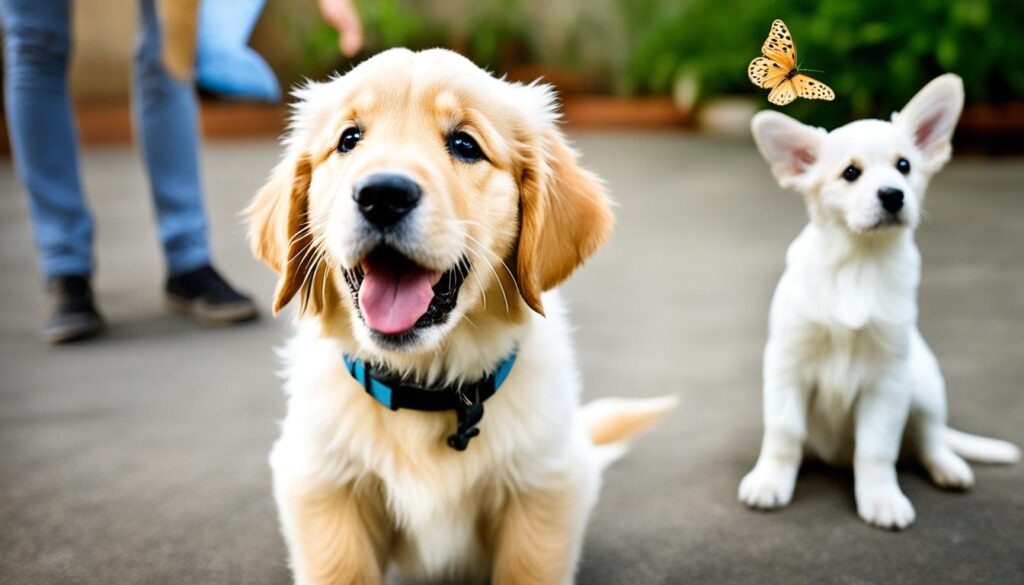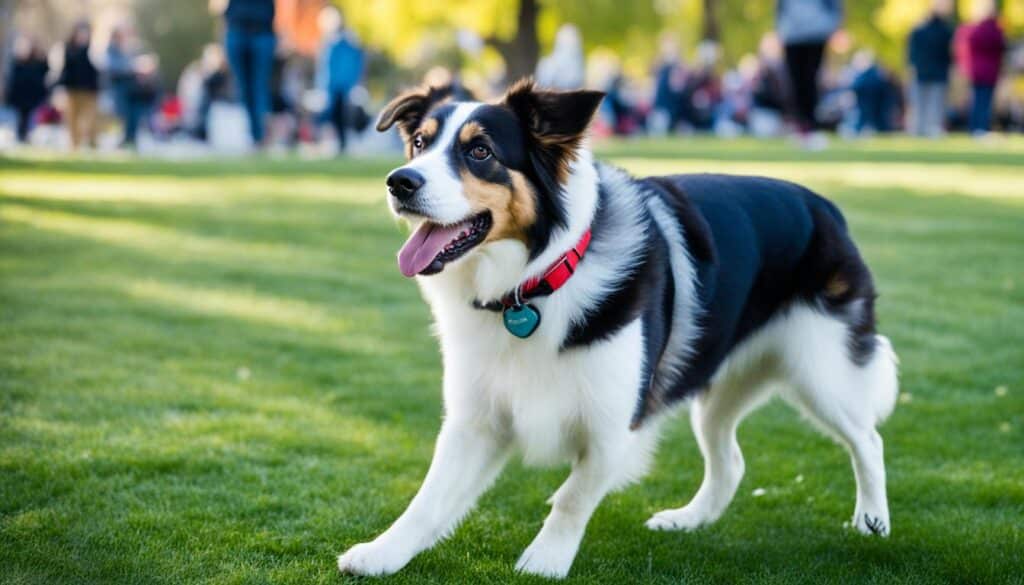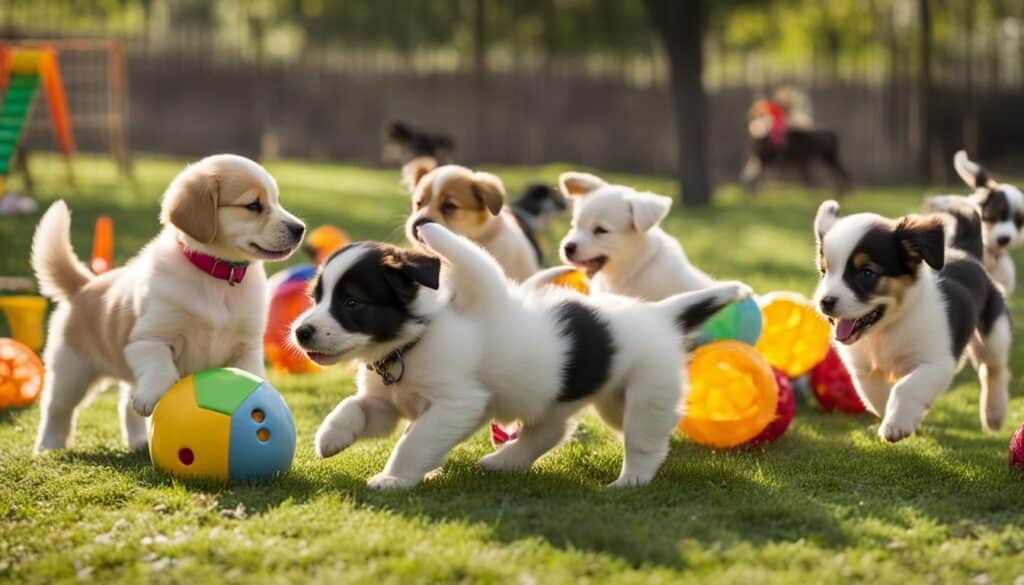Are you tired of your daily walks with your dog turning into a battle of constant distractions? It’s time to regain control and enjoy undistracted walks with your furry friend. Training your dog to ignore distractions is the key to peaceful and enjoyable walks, where you can focus on bonding and exploring the world together.
This article will explore the importance of undistracted walks and how training your dog can help them ignore distractions effortlessly. We’ll delve into the root causes of distraction in dogs, the different types of distractions they encounter, and how their environment can impact their focus. You’ll also discover the benefits of distraction training for you and your dog and learn practical techniques for training.

Walking your dog should be an enjoyable experience with quality time and connection. Teaching your dog to ignore distractions can create a stronger bond and a more pleasurable walking routine.
Key Takeaways:
- Distraction training is crucial for peaceful and enjoyable walks with your dog.
- Understanding the root causes of distraction and the types of distractions dogs face can help in training.
- Creating a structured distraction training plan and using positive reinforcement is critical to success.
- Practical tips, such as encouraging attention and utilizing leash and bark control, can aid in training.
- Redirecting your dog’s attention gently and employing advanced techniques in high-distraction areas can further enhance their focus.
Why does my dog get distracted so easily?
To effectively train your dog to ignore distractions, it is essential to understand why dogs can be easily distracted. Several root causes of distraction in dogs contribute to their tendency to lose focus during walks or training sessions.
Understanding the Root Causes of Distraction in Dogs
Dogs have instincts and behaviors that can make them prone to distraction. Some of the root causes of distraction include:
- Prey drive: Dogs have an innate instinct to chase and hunt prey, which can make them easily distracted by small animals or moving objects.
- Social tendencies: Dogs are social creatures who are often interested in interacting with other dogs, humans, or strangers. This social behavior can lead to distractions during walks or training sessions.
- Lack of training: Dogs that have yet to receive proper training may have difficulty ignoring distractions. They may become easily overwhelmed or excited in new environments without consistent guidance.
- Boredom or lack of mental stimulation: Dogs that are not mentally stimulated or engaged may seek out distractions to alleviate boredom or release pent-up energy.
Different Types of Distractions: From Squirrels to Other Dogs
Dogs can be distracted by a wide range of stimuli in their environment. Common types of distractions include:
- Squirrels and other small animals: The sudden movement or presence of squirrels, birds, or other small animals can easily capture a dog’s attention and trigger their prey drive.
- Other dogs: The sight or sound of other dogs can be highly distracting for some dogs, especially if they are eager to socialize or assert dominance.
- Noises and sounds: Loud noises such as horns, sirens, or construction work can startle dogs and divert their attention away from their handler.
- Unfamiliar surroundings: Dogs may become distracted in a new or unfamiliar environment, as they may need to explore or investigate their surroundings.
How a Dog’s Environment Influences Their Ability to Focus
A dog’s environment significantly affects their ability to focus and resist distractions. Factors within the dog’s environment that can impact their focus include:
- Presence of other animals: Dogs may find it challenging to ignore distractions when other animals are nearby, such as cats, birds, or even other dogs.
- Unfamiliar sights and smells: New or unfamiliar scents and sights can pique a dog’s curiosity and divert their attention from training or activities.
- Loud noises: Dogs have sensitive hearing and can be easily distracted by loud or sudden noises, such as fireworks or thunderstorms.
- Lack of structure: Dogs thrive in structured environments. A lack of consistent routines or boundaries can make them more susceptible to distractions as they may need help understanding what is expected of them.
To effectively train your dog to ignore distractions, it is essential to address the root causes of distraction and create a focused and controlled training environment that supports their learning and success.

What is distraction training, and how can it help your dog?
Distraction training is a method used to teach dogs to maintain focus and ignore distractions. It involves gradually exposing your dog to various distractions while teaching them to remain calm and attentive. This training can be incredibly beneficial for you and your dog, as it helps improve obedience, increases focus, and enhances self-control.
Distraction Training Explained: A Basic Overview
Distraction training works by desensitizing your dog to distractions. Exposing them to controlled distractions in a structured setting can teach them to maintain their attention on you, even in the presence of temptation. The training typically starts with low-level distractions and gradually progresses to more challenging ones.
The key to distraction training is positive reinforcement. When your dog successfully focuses on you, provide praise, treats, or other rewards to reinforce their behavior. You can teach your dog to associate staying focused with positive outcomes by consistently rewarding attention and ignoring distractions.
The Benefits of Distraction Training for You and Your Dog
The benefits of distraction training are numerous. Not only does it improve your dog’s ability to stay focused and follow commands, but it also strengthens the bond between you and your furry friend. Distraction training builds trust and enhances communication, allowing you to navigate various environments easily.
With distraction training, you can enjoy walks and outings with your dog without constantly battling their urge to chase after squirrels or other dogs. Knowing that your dog is reliably responsive and under control gives you peace of mind, no matter the distractions present.
Setting Your Dog Up for Success with Structured Distraction Training
To ensure successful distraction training, creating a structured training plan is essential. Here are some tips to help you set your dog up for success:
- Start with low-level distractions and gradually increase the difficulty.
- Choose a quiet and familiar training environment initially.
- Keep training sessions short and frequent to maintain your dog’s focus.
- Use high-value rewards, such as their favorite treats or toys, to motivate and reinforce the desired behavior.
- Be patient and consistent in your training approach. Rome wasn’t built in a day, and distraction training takes time and practice.
- Work with a professional dog trainer if you need guidance or support.

Incorporating structured distraction training into your routine can help your dog become more focused and obedient in various situations. Remember always to maintain a positive and encouraging attitude and celebrate small successes. You and your four-legged companion can enjoy undistracted walks and a stronger bond with dedication and patience.
How do you begin training your dog to ignore distractions?
Training a dog to ignore distractions is a fundamental skill that can significantly enhance your walks and strengthen your bond with your furry friend. In this section, we will provide practical guidance to help you train your dog to pay attention to you despite distractions.
First Steps in Training Your Dog to Focus Around Distractions
The key to successful distraction training is to start with small steps and gradually increase the difficulty level. Here are some first steps you can take to begin training your dog to focus around distractions:
- Find a suitable training environment: Start training in a quiet and familiar area, such as your backyard or a peaceful park with minimal distractions.
- Start with low-level distractions: Begin training by introducing your dog to low-level distractions, such as mild noises or gentle movements. This will help your dog gradually build tolerance and focus.
- Use positive reinforcement: Reward your dog with treats, praise, and affection whenever they successfully ignore a distraction and focus on you. Positive reinforcement will encourage your dog to repeat the desired behavior.
Using Leash and Bark Control as Tools in Distraction Training
Leash and bark control can be valuable tools in distraction training, helping you redirect your dog’s attention back to you when they become distracted. Here are some tips on using leash and bark control effectively:
- Use a well-fitted leash: Ensure your dog’s leash is appropriate and securely attached to their collar or harness. This will give you better control over their movements during training sessions.
- Practice leash redirection: When your dog gets distracted, gently redirect their attention by lightly pulling on the leash and guiding them back towards you. Reward them when they respond positively.
- Consider bark control devices: If your dog tends to bark excessively and lose focus, consider using bark control devices, such as anti-bark collars or citronella sprays, to help minimize distractions and encourage attention.
Encouraging Your Dog to Pay Attention: Tips and Tricks
Aside from leash and bark control, you can use various other techniques to encourage your dog to pay attention to you. Here are some tips and tricks:
- Use high-value treats: Use treats your dog finds irresistible as rewards for paying attention to you. This will help create a positive association with focusing on you and reinforce the desired behavior.
- Keep training sessions short and engaging: Dogs have a limited attention span, so keep them short and engaging to maintain their interest. Incorporate games and play into the training routine to make it fun for both of you.
- Minimize distractions gradually: As your dog becomes more proficient at ignoring distractions, gradually increase distractions during training sessions. This will challenge them to maintain focus in progressively more distracting situations.
With consistent training and patience, your dog can learn to ignore distractions and focus on you, even in challenging environments. Remember to reward your dog for their efforts and celebrate their progress!
Keeping your dog focused: Practical training tips for owners.
Having a structured training program is critical when training your dog to ignore distractions and stay focused. You can create an environment that promotes learning and focus by setting clear goals and establishing a consistent routine. Here are some practical tips to help you keep your dog focused during training sessions:
Create a Training Program That Works: Structuring Your Training Sessions
Structure is essential in any training program. Start by determining the specific behaviors or commands you want to work on with your dog. Break down each behavior into smaller steps and tackle them individually. This allows your dog to understand and build upon their progress, ensuring a solid foundation.
Set aside regular training sessions in a quiet and undistracted area. Keep the sessions short and focused, around 10-15 minutes, as dogs have shorter attention spans. Consistency is critical, so try to train your dog at the same time each day. Remember to end the session positively and celebrate your dog’s progress.
The Role of Rewards and Positivity in Training Your Dog to Listen
Positive reinforcement is a powerful tool in dog training. You create positive associations and motivation by rewarding your dog for desired behaviors. Use treats, praise, and petting to reward your dog when they exhibit the desired focus and attention. This encourages them to repeat the behavior in the future.
Be generous with rewards, especially in the early stages of training. As your dog becomes more proficient, gradually reduce the frequency of treats and focus more on verbal praise and affectionate gestures. Consistent positive reinforcement builds a strong bond between you and your dog, making the training process enjoyable for both of you.
Adjusting Your Training Techniques Based on the Level of Distraction
Dogs can be easily distracted by various stimuli in their environment. When training your dog, starting with low-level distractions and gradually increasing the difficulty is essential. This allows your dog to build their focus and resist distractions over time.
If your dog struggles with a particular distraction, such as other dogs or squirrels, incorporate controlled exposure to these distractions during training sessions. Use the opportunity to reinforce their focus and reward them for resisting the temptation to chase or react.
Be patient and understanding during training. Dogs learn at their own pace, so it’s essential to adjust your training techniques to suit your dog’s individual needs. Some dogs may require more time and practice to overcome distractions, while others may progress more quickly. Stay consistent and adapt your approach as necessary to ensure adequate training.
By creating a structured training program, using rewards and positivity, and adjusting your techniques to the level of distraction, you can help your dog stay focused during training sessions. Remember always to be patient and consistent and provide plenty of encouragement. With time and consistent effort, your dog will develop the skills to ignore distractions and stay focused on you.
When your dog is distracted: How to gently redirect their attention
To effectively train your dog to ignore distractions, it is crucial to have strategies in place for gently redirecting their attention. Dogs are naturally curious and can easily get sidetracked, so it’s essential to be prepared to guide them back on track. Here are some strategies to help you redirect your dog’s attention and maintain their focus:
Strategies for Redirecting a Distracted Dog Back to You
When you notice that your dog is getting distracted, try these techniques to redirect their attention:
- Use a signal or cue: Develop a specific signal or cue that tells your dog to focus on you. This can be a hand gesture, a word, or a sound. Practice using this cue during training sessions and reinforce it with rewards when your dog responds.
- Offer a high-value reward: Use treats or toys that your dog finds highly motivating to redirect their attention. Show them the reward and guide their focus towards you. When they respond and refocus, reward them generously.
- Engage in interactive play: If your dog becomes distracted during a walk or training session, initiate a quick game of fetch or tug-of-war to redirect their energy and attention back to you.
- Change the environment: If the distraction is too overwhelming, consider moving to a quieter or less stimulating area. You can minimize distractions and regain your dog’s focus by changing the environment.
Teach Your Dog to Respond to a Cue That Means ‘Focus on Me’
To train your dog to respond to a cue that indicates the need for focus, follow these steps:
- Choose a specific word or phrase: Select a cue word or phrase, such as “focus” or “look at me.”
- Pair the cue with rewards: Use positive reinforcement to associate the cue with rewards. Say the cue and immediately reward your dog when they make eye contact with you.
- Practice in different situations: Gradually introduce distractions while practicing the cue. Start with low-level distractions and gradually increase the difficulty as your dog becomes more proficient.
- Consistency is key: Use the cue consistently and reinforce the behavior with rewards each time your dog responds. This will help them understand and learn the cue more effectively.
Maintaining Calm and Patience: The Keys to Successful Redirection
When redirecting your dog’s attention, remaining calm and patient is essential. Dogs can sense your emotions; becoming frustrated or irritated may hinder their training progress. Here are some tips to maintain calm and patience:
- Take deep breaths: If you feel frustrated, pause and take a few deep breaths to calm yourself down. This will help you approach the situation with a clear mind.
- Stay positive: Focus on your dog’s progress rather than dwelling on setbacks. Positive reinforcement and encouragement go a long way in training.
- Keep training sessions short: Dogs have a limited attention span, so keeping them short and engaging is essential. This will help prevent you and your dog from getting overwhelmed or bored.
- Be consistent: Consistency is vital in training. Use techniques, cues, and rewards consistently to reinforce desired behaviors and help your dog stay focused.
Remember, redirecting your dog’s attention takes time and patience. Your dog will learn to ignore distractions and focus on you with consistent training and gentle guidance.
Advanced distraction training techniques: For dogs who can’t ignore that squirrel
Ignoring specific distractions like squirrels can be a real challenge for some dogs. This final section will explore advanced distraction training techniques to help your dog overcome this struggle and stay focused. Gradually increasing distraction and training in high-distraction areas can help your dog generalize their learned behaviors and improve their ability to ignore specific distractions.
Challenging Your Dog: Moving Training to High-Distraction Areas
To take your dog’s distraction training to the next level, gradually exposing them to high-distraction areas is essential. This could include parks, busy streets, or places with many people and other animals. By practicing in these environments, your dog will become more accustomed to distractions and better equipped to stay focused on you. Remember to start with lower distractions and gradually increase the difficulty as your dog progresses.
Training Your Dog to Ignore Specific Distractions Like “The Squirrel Problem”
If your dog struggles with ignoring distractions, such as squirrels, there are specific techniques you can use to address this challenge. One effective strategy is incorporating a “leave it” command during training sessions. Start using the command when your dog notices the distraction and reward them for redirecting their attention back to you. Consistency and positive reinforcement will help your dog associate the distraction with ignoring it and focusing on you instead.
How to Know When Your Dog Has Mastered the Art of Ignoring Distractions
Recognizing when your dog has mastered the art of ignoring distractions is essential in training. Signs of progress include your dog consistently responding to your commands even in high-distraction environments, maintaining focus on you despite distractions, and recovering quickly when momentarily distracted. Remember, each dog learns at their own pace, so be patient and celebrate their achievements along the way.
With these advanced distraction training techniques, you can empower your dog to ignore specific distractions and remain focused on you. By gradually increasing the level of distraction, training in high-distraction areas, and implementing strategies tailored to your dog’s challenges, you’ll help them master the art of ignoring distractions and enjoy undistracted walks together.

